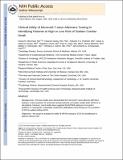| dc.contributor.author | Merchant, Faisal M. | |
| dc.contributor.author | Ikeda, Takanori | |
| dc.contributor.author | Pedretti, Roberto F.E. | |
| dc.contributor.author | Salerno-Uriarte, Jorge A. | |
| dc.contributor.author | Chow, Theodore | |
| dc.contributor.author | Chan, Paul S. | |
| dc.contributor.author | Bartone, Cheryl | |
| dc.contributor.author | Hohnloser, Stefan H. | |
| dc.contributor.author | Cohen, Richard J. | |
| dc.contributor.author | Armoundas, Antonis A. | |
| dc.date.accessioned | 2016-05-22T22:57:50Z | |
| dc.date.available | 2016-05-22T22:57:50Z | |
| dc.date.issued | 2012-03 | |
| dc.identifier.issn | 15475271 | |
| dc.identifier.uri | http://hdl.handle.net/1721.1/102580 | |
| dc.description.abstract | Background
Previous studies have demonstrated that microvolt T-wave alternans (MTWA) testing is a robust predictor of ventricular tachyarrhythmias and sudden cardiac death (SCD) in at-risk patients. However, recent studies have suggested that MTWA testing is not as good a predictor of “appropriate” implantable cardioverter-defibrillator (ICD) therapy as it is a predictor of SCD in patients without ICDs.
Objective
To evaluate the utility of MTWA testing for SCD risk stratification in patients without ICDs.
Methods
Patient-level data were obtained from 5 prospective studies of MTWA testing in patients with no history of ventricular arrhythmia or SCD. In these studies, ICDs were implanted in only a minority of patients and patients with ICDs were excluded from the analysis. We conducted a pooled analysis and examined the 2-year risk for SCD based on the MTWA test result.
Results
The pooled cohort included 2883 patients. MTWA testing was positive in 856 (30%), negative in 1627 (56%), and indeterminate in 400 (14%) patients. Among patients with a left ventricular ejection fraction (LVEF) of ≤35%, annual SCD event rates were 4.0%, 0.9%, and 4.6% among groups with MTWA positive, negative, and indeterminate test results. The SCD rate was significantly lower among patients with a negative MTWA test result than in patients with either positive or indeterminate MTWA test results (P <.001 for both comparisons). In patients with an LVEF of >35%, annual SCD event rates were 3.0%, 0.3%, and 0.3% among the groups with MTWA positive, negative, and indeterminate test results. The SCD rate associated with a positive MTWA test result was significantly higher than that associated with either negative (P <.001) or indeterminate MTWA test results (P = .003).
Conclusions
In patients without ICDs, MTWA testing is a powerful predictor of SCD. Among patients with an LVEF of ≤35%, a negative MTWA test result is associated with a low risk for SCD. Conversely, among patients with an LVEF of >35%, a positive MTWA test result identifies patients at significantly heightened SCD risk. These findings may have important implications for refining primary prevention ICD treatment algorithms. | en_US |
| dc.description.sponsorship | National Institute on Aging (Grant 1R21AG035128) | en_US |
| dc.description.sponsorship | National Institutes of Health (U.S.) (Grant 1RO1HL103961) | en_US |
| dc.description.sponsorship | Center for Integration of Medicine and Innovative Technology | en_US |
| dc.language.iso | en_US | |
| dc.publisher | Elsevier | en_US |
| dc.relation.isversionof | http://dx.doi.org/10.1016/j.hrthm.2012.03.014 | en_US |
| dc.rights | Creative Commons Attribution-NonCommercial-NoDerivs License | en_US |
| dc.rights.uri | http://creativecommons.org/licenses/by-nc-nd/4.0/ | en_US |
| dc.source | PMC | en_US |
| dc.title | Clinical utility of microvolt T-wave alternans testing in identifying patients at high or low risk of sudden cardiac death | en_US |
| dc.type | Article | en_US |
| dc.identifier.citation | Merchant, Faisal M., Takanori Ikeda, Roberto F.E. Pedretti, Jorge A. Salerno-Uriarte, Theodore Chow, Paul S. Chan, Cheryl Bartone, Stefan H. Hohnloser, Richard J. Cohen, and Antonis A. Armoundas. “Clinical Utility of Microvolt T-Wave Alternans Testing in Identifying Patients at High or Low Risk of Sudden Cardiac Death.” Heart Rhythm 9, no. 8 (August 2012): 1256–1264.e2. | en_US |
| dc.contributor.department | Institute for Medical Engineering and Science | en_US |
| dc.contributor.department | Harvard University--MIT Division of Health Sciences and Technology | en_US |
| dc.contributor.mitauthor | Cohen, Richard J. | en_US |
| dc.contributor.mitauthor | Armoundas, Antonis A. | en_US |
| dc.relation.journal | Heart Rhythm | en_US |
| dc.eprint.version | Author's final manuscript | en_US |
| dc.type.uri | http://purl.org/eprint/type/JournalArticle | en_US |
| eprint.status | http://purl.org/eprint/status/PeerReviewed | en_US |
| dspace.orderedauthors | Merchant, Faisal M.; Ikeda, Takanori; Pedretti, Roberto F.E.; Salerno-Uriarte, Jorge A.; Chow, Theodore; Chan, Paul S.; Bartone, Cheryl; Hohnloser, Stefan H.; Cohen, Richard J.; Armoundas, Antonis A. | en_US |
| dspace.embargo.terms | N | en_US |
| dc.identifier.orcid | https://orcid.org/0000-0002-5573-0137 | |
| mit.license | PUBLISHER_CC | en_US |
